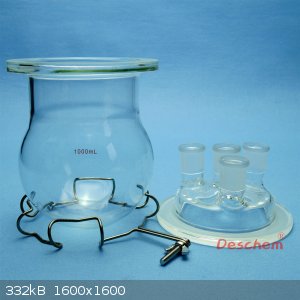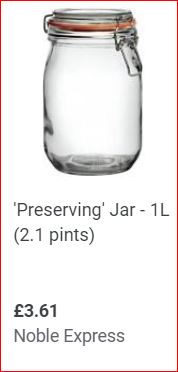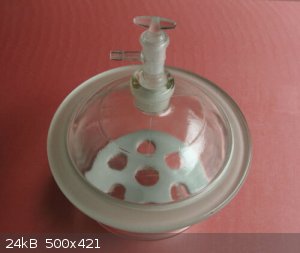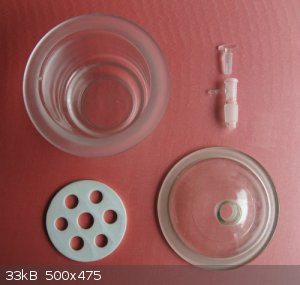Refinery
Hazard to Others
  
Posts: 371
Registered: 17-2-2014
Member Is Offline
Mood: Still
|
|
Using reactor flasks as desiccators?
I looked through desiccators, and though why a reactor type flask could not be used as desiccator? It has a similar structure, but it could also used
for other purposes. The device prices command a similar price to equal size desiccators.
For example attached picture.

|
|
|
Eddie Current
Hazard to Self
 
Posts: 78
Registered: 25-7-2018
Member Is Offline
|
|
Quote: Originally posted by Refinery  | I looked through desiccators, and though why a reactor type flask could not be used as desiccator? It has a similar structure, but it could also used
for other purposes. The device prices command a similar price to equal size desiccators.
For example attached picture.
|
A coffee jar could be used as a desiccator, it all depends on what you're trying to do.
That very nice reactor would not be my first choice as a desiccator.
|
|
|
SWIM
National Hazard
   
Posts: 970
Registered: 3-9-2017
Member Is Offline
|
|
I wouldn't want to apply vacuum to a coffee jar.
I expect Refinery is after a vacuum desiccator.
As long as it is vacuum rated, it ought to make a decent vacuum desiccator I'd think.
You'll want to minimize leakage. good grease, a good valve.
Be aware that not all reaction vessels are vacuum rated.
I've got a 22 liter Morton flask shaped LG vessel which is not vacuum rated.
What you're looking at probably is, but be sure to ask if they don't say so.
A freeze dry flask might also do the trick on a budget.
https://www.ebay.com/itm/Thermovac-500-ml-free-dry-flask-lyo...
These come in various styles. Some have 19/38 fittings for the vacuum.
Virtis is a popular brand.
This is a small one in an older joint style:
https://www.ebay.com/itm/Virtis-Freeze-Dry-Lyophilizer-Round...
[Edited on 14-7-2020 by SWIM]
|
|
|
Eddie Current
Hazard to Self
 
Posts: 78
Registered: 25-7-2018
Member Is Offline
|
|
If the goal is to just use reduced pressure in order to drive out moisture, then a buchner flask & a stopper/hose/inline
tap would also do the job to some extent, but how are you going to utilise desiccants & drying agents in a reactor?
It all comes back to each individual purpose.
Check out the drying pistol I posted in the glassware thread. These are good for smaller amounts of drying.
If you're just looking at an all purpose device, then bite the bullet and get an actual vacuum desiccator with a plate.
The cheaper polycarbonate ones can be picked up new for ~ $70-80 and pull 740mm/hg (24 hours).
[Edited on 14-7-2020 by Eddie Current]
|
|
|
Sulaiman
International Hazard
    
Posts: 3696
Registered: 8-2-2015
Location: 3rd rock from the sun
Member Is Offline
|
|
The main problem that I see is the neck which is probably about 100mm (4") or less wide.
You will also need a plate/stand/trivet, extra stoppers, and something to stop it falling over.
But if the price is close to a similarly sized Dessicator and it is vacuum rated,
I'd choose the reactor because :
. having a reactor at home sounds cool
. useful for all kinds of chemistry and some electrochemistry.
CAUTION : Hobby Chemist, not Professional or even Amateur
|
|
|
SWIM
National Hazard
   
Posts: 970
Registered: 3-9-2017
Member Is Offline
|
|
I would utilize desiccants and drying agents in a reactor by putting them (dry) in the bottom of the reactor.
I know this is a huge change from common desiccator practice, but I bet it just might work.
Why do you think a desiccator would more all purpose for drying than any other similar sized glass vacuum tight vessel?
Even if it somehow was, it still wouldn't be much use as a reaction vessel, or as a continuous extractor, or any of the other things a reaction vessel
can be used for and a plastic box, or even a glass desiccator, can't.
Plastic boxes also have their limits in Organic chemistry because some solvent vapors will eventually weaken the plastic.
BTW: If you can't see the difference between sucking air through a Buchner funnel and drying in a vacuum you ought to consider cracking a book once in
a while.
Or was that just a lame attempt at sophistry on your part?
For small amounts of drying an Abderhalden drying pistol would be more traditional, and would look more like a pistol too.
|
|
|
Refinery
Hazard to Others
  
Posts: 371
Registered: 17-2-2014
Member Is Offline
Mood: Still
|
|
The reactor flask just for the purpose that the opening is large. Normal flask has only for example 24/40 joint, which is the only entrance.
I was supposed to get a stand to put inside the flask so that the drying agent is put on the bottom and the stuff to be dried on top of it, as
ordinary desiccator.
Reactor flasks are cheap, 200 bucks only for 5L model including 4-neck flange. A similar desiccator costs around the same.
|
|
|
Eddie Current
Hazard to Self
 
Posts: 78
Registered: 25-7-2018
Member Is Offline
|
|
Quote: Originally posted by SWIM  |
Why do you think a desiccator would more all purpose for drying than any other similar sized glass vacuum tight vessel?
|
The fact that it comes with a plate, separate desiccant area & stop cock for such purposes.
Quote: Originally posted by SWIM  | BTW: If you can't see the difference between sucking air through a Buchner funnel and drying in a vacuum you ought to consider cracking a book once in
a while.
|
Apologies, I meant Buchner (vacuum) flask.
See above.
|
|
|
Refinery
Hazard to Others
  
Posts: 371
Registered: 17-2-2014
Member Is Offline
Mood: Still
|
|
Stopcocks are available for few bucks for every joint.
Bonus of reactor flask is its use as sublimator with jointed coldfingers.
|
|
|
Dr.Bob
International Hazard
    
Posts: 2734
Registered: 26-1-2011
Location: USA - NC
Member Is Offline
Mood: No Mood
|
|
But you can buy a used real vacuum desiccator for much less than a good reactor, that is 5 times larger, will hold a vacuum better (due to flange
being designed for that purpose alone), and will keep things dry for months with some drying agent. Why bother? The reactor is better used to
react stuff.
|
|
|
wg48temp9
National Hazard
   
Posts: 784
Registered: 30-12-2018
Location: not so United Kingdom
Member Is Offline
|
|
You could use one of these:

You can make holes in the lid for pipes with one of these:

[Edited on 7/14/2020 by wg48temp9]
I am wg48 but not on my usual pc hence the temp handle.
Thank goodness for Fleming and the fungi.
Old codger' lives matters, wear a mask and help save them.
Be aware of demagoguery, keep your frontal lobes fully engaged.
I don't know who invented mRNA vaccines but they should get a fancy medal and I hope they made a shed load of money from it.
|
|
|
Mateo_swe
National Hazard
   
Posts: 541
Registered: 24-8-2019
Location: Within EU
Member Is Offline
|
|
I have bought a Chinese desiccator with ceramic plate and a glass vacuum valve on top.
But it does not keep the vacuum for very long even though i used lots of vacuum grease on the contact ring and valve.
It surprised me as i thought it would keep the vacuum for several days.
However i havent tried it with any stronger vacuum, only with a small vacuum pump i use for filtrations.
Maybe it will preform better with aspirator vacuum or a decent vacuum pump.
I will try it with aspirator vacuum soon and hopefully it keep the vacuum for longer period of time.
If you dont need the vacuum you can use whatever airtight box/flask/plastic bag as a desiccator.7
Just put a bowl with the drying agent in a plastic bag and the chem to be dried in a beaker in the bowl.
The vacuum makes it go faster and for some special chemicals vacuum might be needed but not normally.
|
|
|
outer_limits
Hazard to Others
  
Posts: 139
Registered: 3-3-2020
Member Is Offline
Mood: hybridized
|
|
How long do they keep vacuum?
I was considering to buy Chinese one.
They are much cheaper than more recognizable brands but if they are unable to keep low pressure it is pointless to spend any money for it.
|
|
|
Eddie Current
Hazard to Self
 
Posts: 78
Registered: 25-7-2018
Member Is Offline
|
|
Quote: Originally posted by wg48temp9  | You could use one of these:
You can make holes in the lid for pipes with one of these:
[Edited on 7/14/2020 by wg48temp9] |
If you could get it to seal, then how much vacuum do you think you could put on that thing before it imploded?
Quote: Originally posted by Dr.Bob  | | But you can buy a used real vacuum desiccator for much less than a good reactor, that is 5 times larger, will hold a vacuum better (due to flange
being designed for that purpose alone), and will keep things dry for months with some drying agent. Why bother? The reactor is better used to
react stuff. |
Utilising a reactor as a desiccator is like utilising a Ferrari to plough a field.
Reactor's are restricted choice glassware in my location, whereas desiccators are easily accessed, and relatively cheap
|
|
|
Eddie Current
Hazard to Self
 
Posts: 78
Registered: 25-7-2018
Member Is Offline
|
|
Quote: Originally posted by outer_limits  | How long do they keep vacuum?
I was considering to buy Chinese one.
They are much cheaper than more recognizable brands but if they are unable to keep low pressure it is pointless to spend any money for it.
|
If folks are experiencing vacuum leakage with their desiccator, then the first thing I would look at is replacing the O ring:
https://www.youtube.com/watch?v=ry4SDHz3IT4
|
|
|
Mateo_swe
National Hazard
   
Posts: 541
Registered: 24-8-2019
Location: Within EU
Member Is Offline
|
|
There isnt an O-ring on most desiccators.
Maybe on the plastic ones but the glass ones usually only have flat, grounded contact areas that should be lubricated with vacuum grease.
The vacuum valve should also be greased.
Here is how mine looks.
They should keep the vacuum at least 24 hours i think, preferably longer.
 
|
|
|
Herr Haber
International Hazard
    
Posts: 1236
Registered: 29-1-2016
Member Is Offline
Mood: No Mood
|
|
I wouldnt pull a vacuum on a reactor.
Actually, a pothead friend asked me if I would pull a vacuum on his BHO. I said yes, then thought it over and said no.
My reactors are cylindrical so even less resistance than your round one.
The trouble with the dessicator with the O ring is... they're not made of glass ! Heat and chemical resistance is what I expect from a dessicator.
The spirit of adventure was upon me. Having nitric acid and copper, I had only to learn what the words 'act upon' meant. - Ira Remsen
|
|
|
SWIM
National Hazard
   
Posts: 970
Registered: 3-9-2017
Member Is Offline
|
|
"Most reactors are designed to achieve high degrees of vacuum" -Ace Glass catalogue.
I'm pretty comfortable with using manufacturer recommendations as my guide.
PYREX is rather coy about their cylindrical reactors.
their 2000 ml models were sometimes adapted as sublimators and sold commercially, but the 4000 ml one that's sitting out in my backyard has a vague
warning to check the current catalogue in case they decided to change the rating retroactively.
I think reactor accidents are more likely to be caused by heating it wrong.
Their big weakness is thermal stress.
They really need low watt-density heating, or a heating bath.
"Heating/cooling rates are limited to 1 degree per minute." -Ace Glass catalogue
Don't know f this applies to other companies, but reactors are awfully thick.
[Edited on 15-7-2020 by SWIM]
[Edited on 15-7-2020 by SWIM]
|
|
|
Refinery
Hazard to Others
  
Posts: 371
Registered: 17-2-2014
Member Is Offline
Mood: Still
|
|
Just out of interest, what are reactors good/better than ordinary flasks or similar vessels of size?
Apart from easier access due to large outlet.
|
|
|
Dr.Bob
International Hazard
    
Posts: 2734
Registered: 26-1-2011
Location: USA - NC
Member Is Offline
Mood: No Mood
|
|
Most real reactors are jacketed for easy heating and cooling. Others are designed for a heating mantle. The separate tops and bottoms allow more
flexibility for what size joints and inlets and outlets you can use. It takes special work to clean many reactors, as most are fixed in place and
cleaned in-situ.
Often they are used for the same reaction over and over, so that step is not always even needed. The extra inlets can make keeping an inert
asmosphere easier, by keeping the reactor always under pressure. I just used a setup like that for a highly pyrophoric reaction, where the reagents
are all added cold, then warmed up and the solution is transferred to another flask for quenching in water/ice under nitrogen, using the same flask 4
times before taking it apart or cleaning it. If you are careful it stays dry and airfree between uses. Of course you can use a multineck flask also
that purpose.
But they are mostly used to allow you to test the fixed reactor designs for chemistry that you plan to scale up further. It is very tough to move
from a round bottom flask to a 50 L reactor without going through a smaller reactor first. Cylindrical reactors stir differently, and most use a
paddle, not a stirbar.
|
|
|